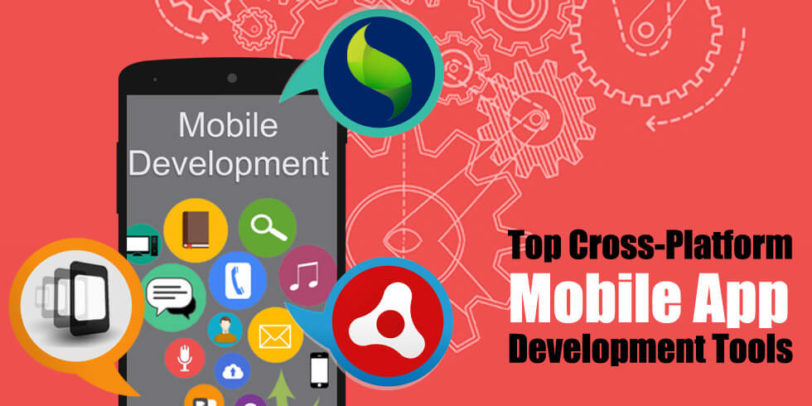Cross Platform Mobile App Development: Top 10 Tools For Rapid Application Development
The invention of mobile apps has considerably improved the connectivity and interactions of businesses with customers. 82% of business owners believe that custom apps have helped them earn additional business revenues. A lot of mobile app development platforms are available for developers, but among them, cross-platform mobile app development tools have gained immense popularity these days. By the end of 2018, it is expected that the cross-platform app market will hit above $7.5 billion.
Before the advent of cross-platform app development tools, releasing an app on multiple platforms was the biggest challenge for the app developers. Developers had to write the code for an application from the scratch for every platform. Then, the concept of cross-platform mobile app development came in the scenario – Write Once Run Anywhere (WORA). WORA refers to a piece of code that is written once on one platform but runs on multiple platforms.
The cross-platform apps work on multiple operating systems with a single programming language. The latest app code supports the concept of Write Once Run Anywhere (WORA). Cross-platform mobile app development tools help save time, streamline the process and minimize the efforts on the part of the developer.
In this article, we have provided a list of most popular cross-platform app development tools that are being used by businesses of all sizes – from startups to Fortune 500 companies.
- Xamarin
This tool allows developers to use the same IDE, APIs, and languages everywhere. The native iOS, Android, and Windows apps run on multiple platforms using only C# code base. Big companies like Microsoft, IBM, Xoriant, Dow Jones, etc., have used Xamarin to develop their apps.
Pros:
- This framework has its own Integrated Development Environment (IDE).
- Compiles apps in native form.
- The tool has a library which allows writing native UIs once and these can be shared on multiple platforms.
- With C# as a code base, this language allows bugs to be identified while the code is running.
- Xamarin focuses on UI and back-end logic.
- Overall cost is low.
Cons:
- The free version of Xamarin offers limited features.
- Does not allow to use open-source libraries due to compatibility issues.
- NativeScript
NativeScript framework was announced by Telerik in 2014. This open-source cross-platform mobile app development tool utilizes JavaScript as its base language. NativeScript also supports Angular.js 2, TypeScript and uses CSS for styling. The developer can easily reuse the same code base for both Android and iOS.
Pros:
- It follows “learn once, write everywhere” protocol – code once and port application everywhere.
- Available on all major platforms (Linux, Windows, MacOS).
- Use JavaScript or XML to build UI.
- Native UI components, UX, and performance.
- Offers an exclusive user experience.
- Unbeaten choice for agile development.
Cons:
- Resources are not extensive.
- Cross-platform UI abstractions.
- PhoneGap (Apache Cordova)
Apache Cordova, originally named as PhoneGap, is one of the highly functional cross-platform mobile app development tools. It comprises of a compiler, a couple of tools for testing purposes, and a debugger. As of now, the Adobe-owned tool is based on Apache Cordova including PhoneGap Build and PhoneGap. Furthermore, Adobe is working on PhoneGap’s enterprise version to enhance marketing features via Adobe’s Marketing Cloud.
Pros:
- Strong and robust backend.
- Hybrid cross-platform frameworks HTML and CSS help create GUI across different operating systems.
- With libraries like framework7, it is possible to support the operating system’s default UI using CSS-based themes.
- No delay in loading the UI related code.
- 85-90% of the code can be reused across various platforms.
- Variety of plugins for utility and programming- Media Recorder Plugin, Image Capture Plugin, Push Plugin, etc.
- Easy to create Android and iOS apps in the cloud without the need for local SDKs (Software Development Kits).
- Supports in-app purchases for the iOS app store and Google Play Store.
Cons:
- It is not suitable for graphic intensive apps.
- Appcelerator Titanium
Appcelerator is an enterprise-focused cross-platform development tool that lets developers deploy JavaScript codebase with its Alloy MVC framework, OS APIs, and eclipse-based IDE studio. The tool supports HTML5 and hybrid apps for platforms like iOS, Android, and BlackBerry. It also offers pre-built integrations with MS SQL, Salesforce, MS Azure, MongoDB, etc.
Pros:
- Excellent platform for Rapid Application Development (RAD).
- Extensible and open.
- Open-source SDK supports more than 5,000 devices.
- Titanium’s SDK creates native Android and iOS apps and helps reuse 60% to 90% of the same code for all the apps.
- Offers a virtual private cloud option for enterprise customers.
Cons:
- The support team is slow in response.
- Sencha Ext JS
Sencha offers a variety of tools for cross-platform mobile app development such as Sencha Animator, Sencha IDE Plugins, Sencha Architect, and more. Sencha’s HTML5-focused approach has drawn the attention of some big organizations such as Google, Samsung, and CNN. Sencha Ext JS 6 is an another Sencha product for enterprise users to build HTML5 apps, which can then be converted into native apps using PhoneGap.
Pros:
- Sencha saves the development time of coding, thus ensuring speedy delivery.
- Quick app design for iOS and Android OS.
- Visual application builder with the reusability of custom components for HTML5.
- Ideal for designing large business applications.
Cons:
- There are limited native looking themes.
- The commercial licensing feature is not easy to comprehend.
- RhoMobile
RhoMobile lets developers develop enterprise-grade, multi-platform, and native mobile applications. Rhomobile leverages Rhodes, a Ruby-based open-source framework, that functions well on Android, iPhone, Windows Mobile, Symbian, and RIM. RhoHub enables developers to code the application while RhoSync, which is an independent server, allows storing updated app data on users’ devices.
Pros:
- Free Eclipse plugin allows to develop, debug, and test applications even in the absence of emulator.
- It is easy to access offline data with Rho Connects.
- Apps developed using this tool are relatively speedy and accurate.
Cons:
- RhoElements RFID plug-in is not available for free for Windows Mobile/CE.
- Flutter
Google’s Flutter is an open-source cross-platform tool for crafting native interfaces on iOS and Android. Flutter is written in Google’s dart language along with C++ runtime. Flutter’s hot reload helps build UIs, add features, and fix bugs faster.
Pros:
- Smooth user-interface for apps.
- Fast and easy development.
- Expressive and highly flexible UI.
- Offers complete native performance on both Android and iOS.
Cons:
- Flutter is still in alpha release phase.
- Flutter doesn’t have fully functional libraries.
- Kony Mobile Platform
Kony Mobile Platform offers a wide range of tools to build multi-platform mobile apps. Features like API connection, automatic coding, and app preview facility make it easier for app developers to develop user-friendly apps. Kony has recently released its Mobile Fabric Platform to bring together multiple middleware tools and cloud service for enterprise-level businesses.
Pros:
- A one-stop shop for UI/UX, integration, back-end management and analytics.
- Fast platform applications.
Cons:
- The scarcity of documentation and support team.
- Monocross
Monocross is an interactive and open-source cross-platform which uses C#, .Net, and the Mono framework. With Monocross, you can retain one code across different platforms.
Pros:
- Support portable applications.
- A diverse range of APIs is supported.
Cons:
- Lack of documentation and support.
- Codename One
Codename One leverages popular IDEs like IntelliJ IDEA, Eclipse, and NetBeans to develop compatible applications. The platform supports rapid application development. The code is written in Java and the app is tested and verified with Codename One’s simulator. The tool is recommended for the upcoming iOS version.
Pros:
- Easy to use.
- Codename One has its own GUI builder and many niceties to track issues.
- Codename One boasts greater portability than HTML5 due to the light-weight structure.
Cons:
- Not supported for larger projects.
- Visual themes are not updated.
- Due to the storage of all event handlers in a single file, development part is cumbersome.
Conclusion:
Cross-platform tools boost and minimize developers’ efforts. The selection of the framework must be done on the basis of project and resource requirement. If you are planning to get a cross-platform mobile app developed for your business, partner with an experienced mobile app development agency.
Author – Bio
Shahid Mansuri Co-founded Peerbits, one of the leading web development company USA, in 2011. His visionary leadership and flamboyant management style have yield fruitful results for the company. He believes in sharing his strong knowledge base with learned concentration on entrepreneurship and business.





